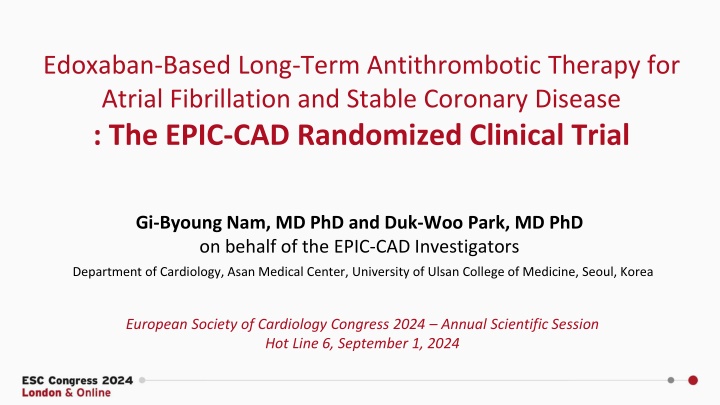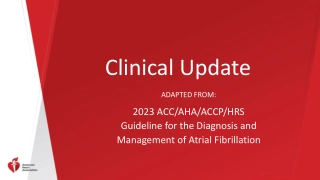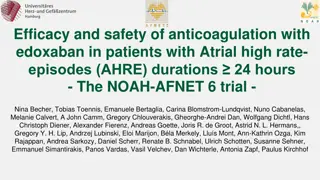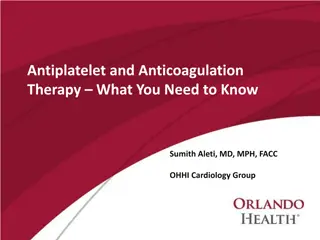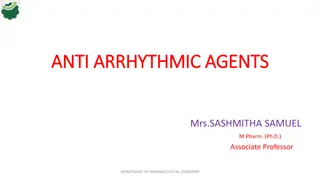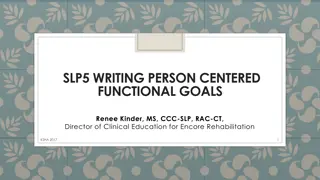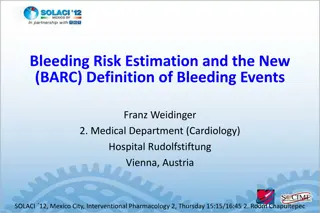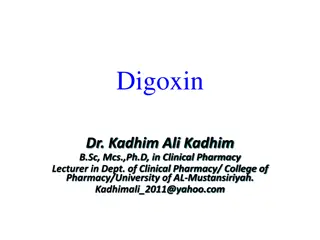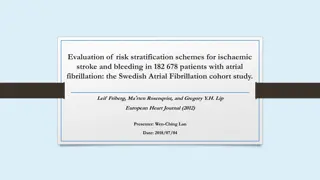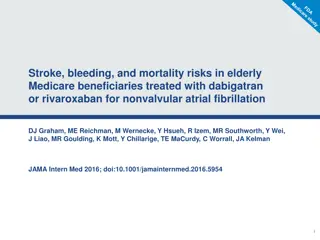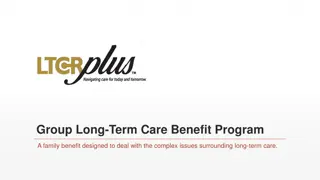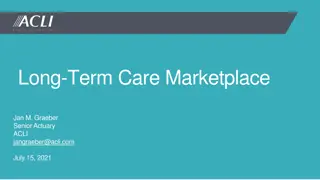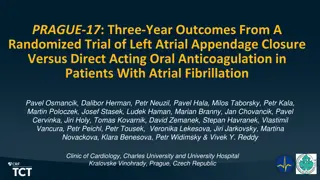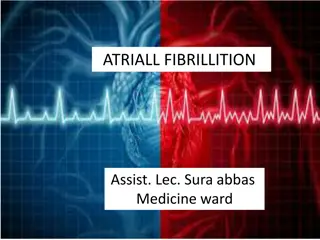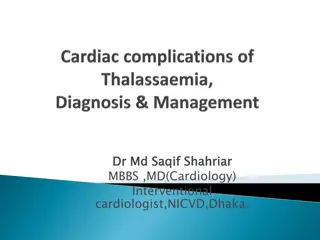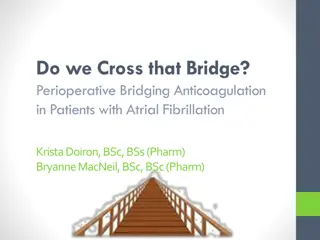Edoxaban-Based Long-Term Antithrombotic Therapy for Atrial Fibrillation and Stable Coronary Disease
The EPIC-CAD randomized clinical trial evaluates the efficacy of edoxaban-based long-term antithrombotic therapy for patients with atrial fibrillation and stable coronary disease. This study addresses the challenge of choosing optimal antithrombotic therapy for individuals with both conditions, aiming to balance the prevention of thromboembolic and ischemic events while minimizing bleeding risks.
Download Presentation

Please find below an Image/Link to download the presentation.
The content on the website is provided AS IS for your information and personal use only. It may not be sold, licensed, or shared on other websites without obtaining consent from the author.If you encounter any issues during the download, it is possible that the publisher has removed the file from their server.
You are allowed to download the files provided on this website for personal or commercial use, subject to the condition that they are used lawfully. All files are the property of their respective owners.
The content on the website is provided AS IS for your information and personal use only. It may not be sold, licensed, or shared on other websites without obtaining consent from the author.
E N D
Presentation Transcript
Edoxaban-Based Long-Term Antithrombotic Therapy for Atrial Fibrillation and Stable Coronary Disease : The EPIC-CAD Randomized Clinical Trial Gi-Byoung Nam, MD PhD and Duk-Woo Park, MD PhD on behalf of the EPIC-CAD Investigators Department of Cardiology, Asan Medical Center, University of Ulsan College of Medicine, Seoul, Korea European Society of Cardiology Congress 2024 Annual Scientific Session Hot Line 6, September 1, 2024
Disclosure Supported by research grant from CardioVascular Research Foundation (CVRF) Daiichi-Sankyo (Tokyo, Japan) & Daewoong Pharmaceutical Co., Ltd (Seoul, Korea).
Background The prevalence of AF is high among patients with CAD; however, choosing optimal antithrombotic therapy for both comorbidities is challenging Patients with AF require anticoagulants to prevent thromboembolic events, whereas CAD require antiplatelets to prevent ischemic events Combined use of anticoagulant and antiplatelet regimens markedly increase the risk of bleeding1-5 AF, atrial fibrillation; CAD, coronary artery disease 1Lancet 2013; 381:1107; 2N Engl J Med 2016;375:2423; 3N Engl J Med 2019; 380:1509; 4N Engl J Med 2017;377:1513; 5Lancet 2019;394:1335
Background: Current AF and CAD Guideline After ACS or PCI up to 6mo 1yr AF and Stable CAD OAC OAC + P2Y12 up to 6mo CCS PCI (+single antiplatelet) +Aspirin 1 mo Post-PCI 6 12mo OAC + P2Y12 up to 12mo ACS PCI Medically treated CAD +Aspirin 1 mo OAC + P2Y12 up to 12mo Medically treated ACS I IIa IIb III WOEST PIONEER AF-PCI AUGUSTUS RE-DUAL PCI ENTRUST-AF PCI OAC-ALONE AFIRE Lancet 2013; 381:1107; N Engl J Med 2016;375:2423; N Engl J Med 2019; 380:1509; N Engl J Med 2017;377:1513; Lancet 2019;394:1335 Circulation 2019;139:604; N Engl J Med 2019;381:1103 ACS, acute coronary syndrome; CCS, chronic coronary syndrome; OAC, oral anticoagulant; PCI, percutaneous coronary intervention Eur Heart J 2020;42:373
Background: Prior RCT (OAC-ALONE and AFIRE) OAC-ALONE trial AFIRE trial Efficacy endpoint* HR 1.16 (0.79-1.72) ISTH major bleeding HR 0.73 (0.44-1.20) Efficacy endpoint ISTH major bleeding 10.4% 7.8% Circulation. 2019;139:604 N Engl J Med 2019;381:1103 Early termination d/t an increased mortality signal Use of locally approved dose rivaroxaban (15 or 10mg once daily in Japan) Early termination d/t futility Failed to show noninferiority Predominant warfarin use * Composite of death, myocardial infarction, stroke, or systemic embolism Composite of death, myocardial infarction, stroke, systemic embolism, or unstable angina requiring revascularization
Objective To compare the efficacy and safety of standard-dose edoxaban monotherapy with the dual antithrombotic therapy (edoxaban + a single antiplatelet agent) in patients with high-risk AF and stable CAD. The primary hypothesis was that edoxaban monotherapy would be superior to dual antithrombotic therapy with respect to the primary net clinical outcome. Cho MS, Kang DY et al. Am Heart J 2022;247:123-131
Edoxaban versus Edoxaban with antiPlatelet agent In patients with atrial fibrillation and Chronic stable Coronary Artery Disease Trial Design investigator-initiated, multicenter, open-label, superiority trial EPIC-CAD Trial 1,038 patients with high-risk AF (CHA2DS2-VASc score 2) and stable CAD A permuted block size of 4 or 6, stratified randomization by trial center Edoxaban monotherapy (N=519) Dual antithrombotic therapy (N=519) Primary endpoint net adverse clinical event (a composites of all-casuse death, stroke, systemic embolic event, myocardial infarction, unplanned urgent revascularization, major bleeding, and clinically relevant non-major bleeding) at 1 year after randomization Cho MS, Kang DY et al. Am Heart J 2022;247:123-131
Enrollment Criteria EXCLUSION CRITERIA INCLUSION CRITERIA 1. Patients with severe thrombocytopenia 2. High risk of bleeding or severe coexisting conditions prohibiting antithrombotic use 3. Prior history of intracranial hemorrhage 4. Mechanical prosthetic valve or moderate-to- severe mitral stenosis 5. Patients contraindicated for use of edoxaban or antiplatelets. 6. Planned PCI or CABG within 1 year after randomization. 7. Liver cirrhosis or severe hepatic dysfunction 8. Severe renal insufficiency (creatinine clearance <15 mL/min) 9. Life expectancy <12 months. 1. Men or women at least age 18 years. 1. Patients with nonvalvular AF (prevalent or paroxysmal) with high embolic risk (CHA2DS2- VASc score 2) 1. Patients with stable CAD Prior revascularization (PCI or CABG) 6M for chronic CAD and 12M for ACS Anatomically confirmed CAD ( 50% stenosis in CAG or CCTA) on medical therapy alone ACS, acute coronary syndrome; CAD, coronary artery disease; CAG, coronary angiography; CCTA, coronary computed tomographic angiography; PCI, percutaneous coronary intervention Cho MS, Kang DY et al. Am Heart J 2022;247:123-131
Randomization and administration of study drug Eligible patients were randomly assigned in a 1:1 ratio to either standard-dose edoxaban monotherapy or dual-antithrombotic therapy (edoxaban + a single antiplatelet agent) by means of a central, IWRS with block sizes of 4 or 6, stratified according to the participating site. Standard-dose edoxaban was used in both group; 60-mg once daily as a standard dose 30-mg once daily with dose-reduction criteria Body-weight 60 kg Creatinine clearance of 15 50 mL/min Concomitant use of P-glycoprotein inhibitors Type of a single antiplatelet agent (either aspirin or a clopidogrel) was selected according to the discretion of the treating physician IWRS, interactive web-based randomization system
Primary trial endpoint Net adverse clinical event : defined as a composite of Death from any causes Myocardial infarction Stroke Systemic embolism Unplanned urgent revascularization Major or clinically relevant nonmajor bleeding event by ISTH definition at 1 year after randomization CI, confidence interval; ISTH, International Society on Thrombosis and Haemostasis
Secondary trial endpoints Individual components of the primary outcome Stent thrombosis Major ischemic events Composites of death, myocardial infarction ischemic stroke, and systemic embolism Any ischemic events (post-hoc) Composites of death, myocardial infarction ischemic stroke, and systemic embolism, and urgent repeat revascularization Composite of major and clinically relevant nonmajor bleeding (by ISTH definition) Fatal bleeding Major bleeding Any bleeding event
Statistical Considerations Power Calculation (N = 1,038) Assuming a 1-year event rate of 18% in the dual antithrombotic therapy group. Statistical power of 80% to detect a relative reduction of 30% in the primary outcome in the edoxaban monotherapy group compared with the dual antithrombotic therapy group at a significance level of 0.05 on the basis of a two-sided log-rank test of survival. Statistical Analysis Primary intention-to-treat analysis Cumulative event rates calculated by Kaplan-Meier estimates and compared with log-rank test Cox proportional hazard models Estimate the risk differences if proportional hazards assumption is not violated Sensitivity and subgroup analysis Per-protocol analysis (randomized groups without major protocol violations) Subgroup analysis for primary endpoint according to the prespecified clinical factors
Participating Investigators and Trial Organization Participating Investigators (18 Sites in South Korea) Gi-Byoung Nam, Duk-Woo Park, Min Soo Cho, Do-Yoon Kang, Jung-Min Ahn, Seung-Jung Park (Asan Medical Centers); Yong-Seog Oh (Seoul St Mary's Hospital); Chang Hoon Lee (Veterans Health Service Medical Center); Eue-Keun Choi (Seoul National University); Ji Hyun Lee (Seoul National University Bundang Hospital); Chang Hee Kwon (Konkuk University Medical Center); Gyung-Min Park (Ulsan University Hospital); Hyung Oh, Choi (Soon Chun Hyang University Hospital Bucheon); Kyoung-Ha Park (Hallym University Medical Center); Kyoung-Min Park (Samsung Medical Center); Jongmin Hwang (Keimyung University Dongsan Hospital); Ki-Dong Yoo (St. Vincent's Hospital); Young-Rak Cho (Dong-A University Hospital); Ji Hyun Kim (Dongguk University Hospital); Ki Won Hwang (Pusan National University Yangsan Hospital); Eun Sun Jin (Kyung Hee University Hospital at Gangdong); Osung Kwon (Eunpyeong St. Mary's Hospital); Ki Hun Kim (Haeundae Paik Hospital) Executive Committee Gi-Byoung Nam (Trial PI) Duk-Woo Park (Trial PI) Min Soo Cho Do-Yoon Kang Additional Steering Committee Yong-Seog Oh Chang Hoon Lee Ji Hyun Lee Chang Hee Kwon Event Adjudication Committee Kee-Joon Choi (Chair) Su-young ParkKyung-Ae Kim Data & Safety Monitoring Board Hyun-Seok Nam (Chair) Junghoon Lee Joongmin Lee Jinsun Park Jae-Seok Bae Suk-won Choi Elly Jeong-youn Bae Trial Funding CardioVascular Research Foundation (CVRF) Daiichi-Sankyo (Tokyo, Japan) & Daewoong Pharmaceutical Co., Ltd (Seoul, Korea).
Patient Flow and Follow-Up (from May 14, 2019, through September 19, 2022) Screened (1393) Randomized (1040) Edoxaban monotherapy (524) Dual antithrombotic therapy(516) 1 Did not met eligibility criteria 12 Cross-over 1 Did not met eligibility criteria 11 Cross-over 2 Withdrew consent 8 Were lost to follow-up 3 Withdrew consent 6 Were lost to follow-up At 12-month follow-up: 514 (98.1%) Completed follow-up At 12-month follow-up: 507 (98.3%) Completed follow-up 524 (100%) Were included in the intention-to-treat analysis 516 (100%) Were included in the intention-to-treat analysis
Baseline Characteristics Edoxaban Monotherapy (N=524) Dual Antithrombotic Therapy (N=516) Age [yrs], mean (SD) 71.7 8.0 72.5 8.4 Male sex 396 (75.6) 406 (78.7) Body-mass index 25.3 3.3 25.4 3.3 Diabetes mellitus no. (%) 224 (42.7) 197 (38.2) Hypertension no. (%) 423 (80.7) 422 (81.8) Previous cerebrovascular disease no. (%) 77 (14.7) 77 (14.9) Previous myocardial infarction no. (%) 79 (15.1) 92 (17.8) Creatinine clearance by Cockcroft Gault formula ml/min 67.0 23.6 66.0 21.4 CHA2DS2-VASc score CHADS2score HAS-BLED score 4.3 1.6 4.4 1.5 2.1 1.2 2.2 1.2 2.1 0.8 2.2 0.8 Type of atrial fibrillation no. (%) Paroxysmal 292 (55.7) 283 (54.8) Persistent or permanent 232 (44.3) 233 (45.2) Indication for dose adjustment of edoxaban no. (%) 178 (34.0) 168 (32.6) Plus minus values are means SD.
Baseline Characteristics Edoxaban Monotherapy (N=524) Dual Antithrombotic Therapy (N=516) Obstructive CAD managed by medical therapy alone no. (%) 188 (35.9) 169 (32.8) Previous coronary revascularization no. (%) 336 (64.1) 347 (67.2) Previous PCI no. (%) 308 (58.8) 318 (61.6) Drug-eluting stent 251 (81.5) 267 (84.0) Bare-metal stent 13 (4.2) 7 (2.2) Both stent types 8 (2.6) 4 (1.3) Unknown stent type 36 (11.7) 40 (12.6) Previous CABG no. (%) 41 (7.8) 36 (7.0) Disease extent no. (%) 1-vessel disease 268 (51.1) 260 (50.4) 2-vessel disease 127 (24.2) 135 (26.2) 3-vessel disease 81 (15.5) 77 (14.9) Left main disease 48 (9.2) 42 (8.1) CABG, coronary artery bypass grafting; CAD, coronary artery disease
Antithrombotic regiments before and after randomization Edoxaban Monotherapy (N=524) Dual Antithrombotic Therapy (N=516) Prior use of antithrombotic strategy before randomization no. (%) None 7 (1.3) 6 (1.2) Antiplatelet agent only 51 (9.7) 42 (8.1) Oral anticoagulants only 253 (48.3) 217 (42.1) Combination of antiplatelets and anticoagulants 213 (40.6) 251 (48.6) Study drug regimens after randomization no. (%) Actual dose of edoxaban used 60mg 317 (60.5) 281 (54.5) 30mg 207 (39.5) 235 (45.5) Type of a single antiplatelet agent Aspirin 1 (0.2) 319 (61.8) Clopidogrel 2 (0.4) 195 (37.8)
Primary Endpoint: Net adverse clinical event Hazard ratio, 0.44 (95% CI, 0.30 0.65) P < 0.001 16.2% Dual antithrombotic therapy Edoxaban monotherapy 6.8% No. at Risk Dual antithrombotic therapy Edoxaban monotherapy 516 524 475 508 452 495 437 487 391 409 Primary net adverse clinical event was defined as a composite of death from any causes, myocardial infarction, stroke, systemic embolism, unplanned urgent revascularization, and major or clinically relevant nonmajor bleeding event
Key Secondary Endpoint: Major ischemic events Hazard ratio, 1.23 (95% CI, 0.48 3.10) Edoxaban monotherapy Dual antithrombotic therapy 1.8% 1.6% No. at Risk Dual antithrombotic therapy Edoxaban monotherapy 516 524 510 516 505 510 499 506 446 428 Major ischemic events: composite of death from any causes, myocardial infarction, ischemic stroke, and systemic embolism
Key Secondary Endpoint: Major or clinically relevant non-major bleeding Hazard ratio, 0.34 (95% CI, 0.22 0.53) 14.2% Dual antithrombotic therapy Edoxaban monotherapy 4.7% No. at Risk Dual antithrombotic therapy Edoxaban monotherapy 516 524 475 512 453 500 441 492 393 414
Type of CV outcomes Edoxaban Monotherapy (N=524) Dual Risk Difference (95% CI) Antithrombotic Therapy (N=516) HR (95% CI) Outcome* Primary composite outcome 34 (6.8) 79 (16.2) 9.41 (5.40 to 13.42) 0.44 (0.30 to 0.65) Secondary outcomes Efficacy outcomes Death 3 (0.6) 3 (0.7) 0.08 (-0.97 to 1.13) 1.29 (0.29 to 5.76) Stroke 7 (1.4) 4 (0.8) -0.60 (-1.89 to 0.69) NR** Myocardial infarction 0 (0) 2 (0.5) 0.46 (-0.18 to 1.11) NR** Unplanned urgent revascularization 7 (1.4) 6 (1.4) 0.0 (-1.50 to 1.50) 1.00 (0.35 to 2.85) Stent thrombosis 0 / 308 (0) 0 / 318 (0) NA NA Major ischemic events 8 (1.6) 8 (1.8) 0.13 (-1.52 to 1.78) 1.23 (0.48 to 3.10) Any ischemic events 15 (3.0) 11 (2.4) -0.55 (-2.63 to 1.53) 1.40 (0.67 to 2.93) *The percentages were estimated by the Kaplan Meier estimates. Hazard ratios are for the edoxaban monotherapy compared to the dual antithrombotic therapy The primary composite outcome was composite of death from any causes, myocardial infarction, stroke, systemic embolism, unplanned urgent revascularization, and major or clinically relevant nonmajor bleeding event. **Hazard ratios were not reported (NR) for outcomes that did not appear to satisfy the proportional-hazards assumption. CI, confidence interval; HR, hazard ratio; NA, not available
Type of CV outcomes Edoxaban Monotherapy (N=524) Dual Risk Difference (95% CI) Antithrombotic Therapy (N=516) HR (95% CI) Outcome* Safety Outcomes Major or clinically relevant nonmajor bleeding 23 (4.7) 70 (14.2) 9.58 (5.92 to 13.24) 0.34 (0.22 to 0.53) Major bleeding 6 (1.3) 22 (4.5) 3.12 (0.99 to 5.25) 0.32 (0.14 to 0.73) Clinically relevant nonmajor bleeding 18 (3.5) 52 (10.6) 7.08 (3.89 to 10.27) 0.36 (0.21 to 0.59) Fatal bleeding 0 (0) 0 (0) NA NA Any bleeding 49 (9.9) 99 (20.1) 10.20 (5.73 to 14.67) 0.48 (0.35 to 0.67) Intracranialhemorrhage 2 (0.4) 3 (0.6) 0.21 (-0.65 to 1.06) 0.70 (0.12 to 4.16) Gastrointestinal hemorrhage 8 (1.6) 13 (2.6) 1.03 (-0.75 to 2.81) NR** *The percentages were estimated by the Kaplan Meier estimates. Hazard ratios are for the edoxaban monotherapy compared to the dual antithrombotic therapy. **Hazard ratios were not reported (NR) for outcomes that did not appear to satisfy the proportional-hazards assumption. CI, confidence interval; HR, hazard ratio; NA, not available.
Sensitivity analysis: Per-protocol analysis Primary net adverse clinical event Major bleeding and clinically relevant non-major bleeding Major ischemic event Hazard ratio 0.32 (95% CI, 0.20-0.50) Hazard ratio 0.42 (95% CI, 0.28-0.61) Hazard ratio 1.23 (95% CI, 0.49-3.12) Cumulative Incidence of Events (%) Cumulative Incidence of Events (%) 16.4% 14.4% Dual antithrombotic therapy Dual antithrombotic therapy Edoxaban monotherapy Dual antithrombotic therapy 1.8% 6.6% Edoxaban monotherapy 4.6% Edoxaban monotherapy 1.7% No. at Risk Months since Randomization Months since Randomization Months since Randomization No. at Risk No. at Risk Dual antithrombotic therapy Edoxaban monotherapy Dual antithrombotic therapy Edoxaban monotherapy Dual antithrombotic therapy Edoxaban monotherapy 504 464 441 427 382 504 464 441 427 382 504 464 441 427 382 511 497 484 476 399 511 497 484 476 399 511 497 484 476 399 Primary net adverse clinical event was composite of death from any causes, myocardial infarction, stroke, systemic embolism, unplanned urgent revascularization, and major or clinically relevant nonmajor bleeding event. Major ischemic event was as a composite of death from any cause, myocardial infarction, ischemic stroke, or systemic embolism.
Prespecified Subgroup Analysis Estimated 1-Yr Event Rate (%) Percent of Patients Subgroup Hazard Ratios (95% CI) Dual antithrombotic therapy Edoxaban monotherapy Age 75 years <75 years Sex Male Female Creatinine clearance 50 mL/min <50 mL/min Last revascularization PCI Bypass grafting Medical treatment Edoxaban dose 60 mg 30 mg Risk of stroke CHA2DS2-VASc 4 CHA2DS2-VASc <4 Risk of bleeding HAS-BLED 3 HAS-BLED <3 42.2 57.8 5.3 7.8 18.7 14.2 0.31 (0.17 to 0.59) 0.56 (0.35 to 0.92) 77.1 22.9 6.0 9.4 17.4 12.1 0.37 (0.23 to 0.58) 0.81 (0.39 to 1.72) 0.41 (0.25 to 0.66) 0.53 (0.28 to 0.99) 75.8 24.2 5.2 12.1 14.5 21.7 59.1 6.5 34.3 6.4 7.4 7.1 17.1 20.6 13.7 0.43 (0.26 to 0.70) 0.46 (0.13 to 1.67) 0.50 (0.26 to 0.99) 57.5 42.5 6.5 7.5 16.4 16.1 0.46 (0.28 to 0.75) 0.44 (0.24 to 0.79) 0.39 (0.24 to 0.63) 0.57 (0.31 to 1.05) 67.3 32.7 6.1 8.2 16.2 16.3 31.8 68.2 7.7 6.5 15.1 16.9 0.48 (0.25 to 0.93) 0.43 (0.27 to 0.69) 0.1 1 10 Dual antithrombotic Therapy Better Edoxaban Monotherapy Better PCI, percutaneous coronary intervention
Post-Hoc Subgroup Analysis Estimated 1-Yr Event Rate (%) Percent of Patients Subgroup Hazard Ratios (95% CI) Dual antithrombotic therapy Edoxaban monotherapy Prior dual antithrombotic therapy Yes 44.6 6.3 14.4 0.46 (0.25 to 0.83) No 55.4 7.2 18.1 0.43 (0.26 to 0.71) Prior anticoagulation Therapy Yes 89.8 7.0 14.9 0.51 (0.34 to 0.76) No 10.2 5.2 30.1 0.18 (0.06 to 0.59) Prior antiplatelet therapy Yes 53.6 6.2 17.3 0.37 (0.22 to 0.63) 0.56 (0.32 to 0.98) No 46.4 7.4 15.2 Appropriateness of edoxaban dose Appropriate dose 86.0 7.1 16.5 0.45 (0.30 to 0.67) Inappropriate dose 14.0 4.9 15.3 0.40 (0.12 to 1.34) Type of antiplatelets Aspirin 62.1 6.8 12.8 0.53 (0.35 to 0.82) Clopidogrel 37.9 6.8 22.3 0.34 (0.22 to 0.52) 0.1 1 10 Edoxaban Monotherapy Better Dual antithrombotic Therapy Better PCI, percutaneous coronary intervention
Study Limitations Open-label design that entailed a risk of reporting or ascertainment bias Not designed to detect potential differences in less common but clinically relevant ischemic outcomes Net adverse clinical event as primary trial end point Relatively higher incidence of bleeding events than ischemic events Bias results in favor of the less potent antithrombotic strategy The generalizability and reproducibility of our trial findings may be potentially limited East Asian population Women were underrepresented
Summary for the EPIC-CAD Trial Findings In this multicenter RCT, use of standard-dose edoxaban monotherapy was associated with a lower risk of primary net adverse clinical events as compared with dual antithrombotic therapy (edoxaban and a single antiplatelet agent) in patients with AF and stable CAD. This result appeared to be driven mainly by a lower incidence of bleeding events. The incidence of ischemic events and mortality appeared to be similar in the trial groups.
Conclusion In this EPIC-CAD involving patients with AF and stable CAD, edoxaban monotherapy was associated with a lower risk of a composite outcomes of death from any cause, myocardial infarction, stroke, systemic embolism, unplanned urgent revascularization, or major bleeding or clinically relevant nonmajor bleeding than dual antithrombotic therapy at 12 months.
30 Ask the Trialist: Deep-Dive EPIC-CAD Trial
